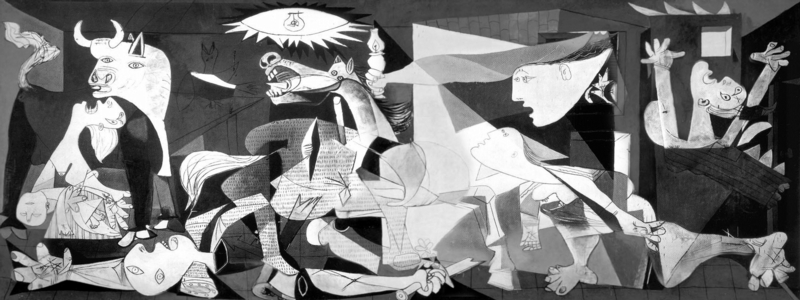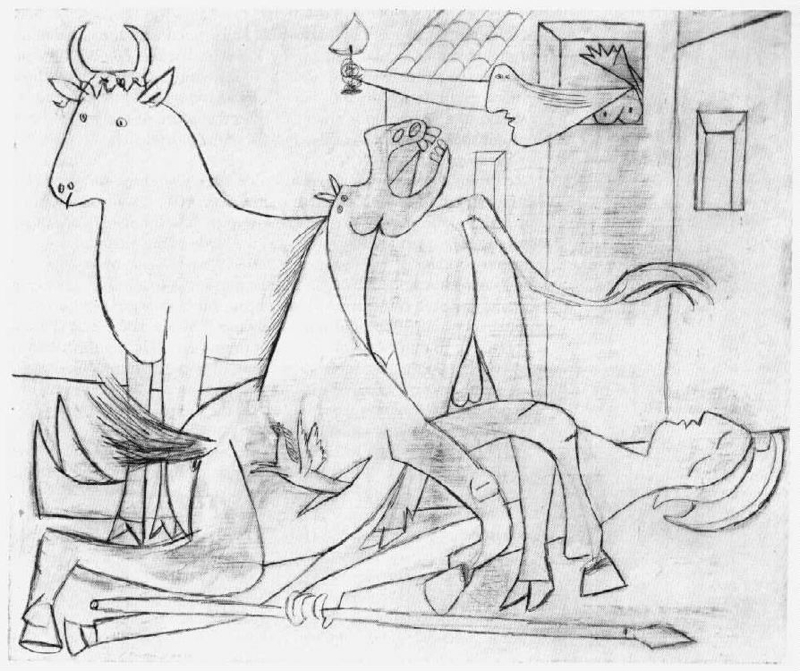The Spanish painter Pablo Picasso (1881-1973) painted a mural depicting the bombing of the Basque town of Guernica by the German air force in 1937 during Spanish Civil War. It depicts the victims of war, such as suffering women, children, and a horse. It is perhaps the greatest painting about war ever made as it focuses on the victims and is timeless and universal in its themes.
Picasso was one of the most innovative and origin artist of the 20th century – perhaps of any century. He was a master of a range of forms: painting, etching, sketches, sculpture, and murals. His amazing creativity enables him to master one form or innovation and then go on to invent another. His life work is a series of cycles of breaking convention, mastering new forms, and then incorporating innovation and tradition into his work. He is associated with the movement known as cubism before WW1. It was a revolutionary way of analysing everyday objects by abandoning the traditional mode of perspective which artists had adopted since the renaissance.
Picasso was relatively unpolitical in his work before Guernica. WW1 had little impact upon him. He was more concerned with the internal logic of his artistic innovations. However the bombing of Guernica in his native Spain forced Picasso to confront the political issues of the late 1930s with the rise of Fascism and Nazism. To rebut rumours of his sympathies for Franco Picasso made a public statement at time while he was working on the Guernica mural:
The Spanish struggle is the fight of reaction against the people, against freedom. My whole life as an artist has been nothing more than a continuous struggle against reaction and the death of art. How could anybody think for a moment that I could be in agreement with reaction and death? When the rebellion began, the legally elected and democratic republican government of Spain appointed me director of the Prado Museum, a post which I immediately accepted. In the panel on which I am working which I shall call Guernica, and in all my recent works of art, I clearly express my abhorrence of the military caste which has sunk Spain in an ocean of pain and death…
Six days after the bombing of Guernica on April 26, 1937 Picasso began work on a mural for the Spanish Pavilion of the International Exhibition in Paris held in the summer of 1937.
Picasso accepted the commission from the Spanish government in January 1937 to paint a mural (11 feet 6 in high by 25 feet 8 in long) for the Spanish pavilion but no topic had been decided upon. The bombing in April provided him with his topic. He painted it in near monochrome (shades of grey with some purplish and bluish and brownish tints). Its evolution was very well documented as we have 45 preliminary studies and 7 photographs of the mural at various stages.
(The Major Components of the Painting)
Description of the mural:
The scene takes place in darkness in an open space, possibly a town square surrounded by burning buildings. Figures within the triangle include a fleeing woman, the wounded horse (perhaps depicting suffering humanity, originally it had a small winged horse/soul leaving the gash in side), the broken statue of the warrior (a classical image perhaps of fallen Spanish republicans). At the tip of the triangle there is an “eye” of an electric light globe (image of sun/eye) and a woman with the lamp (light holding darkness/bull at bay). To the right is a burning building with the falling woman (perhaps also burning, in the stance of the suffering Mary Magdalene). To the left is a wailing woman with a dead baby (originally it was on the ladder, like bringing Christ down from the cross) behind which stands a bull (is it threatening or protecting the woman and child?). Other figures are the bird (rising or falling, originally small winged horse/soul) and the flower (symbol of regeneration and hope, like the 600 year old tree left standing in Guernica’s town square after the bombing attack).
(An early sketch)
For more material on Picasso, see:
- “Pablo Picasso – the Spanish Civil War, WW2 and Korea” – Guide
- lecture on “War & Peace in the Work of Pablo Picasso: “Guernica” (1937)” – Summary and lecture overheads [PDF 19 MB]




